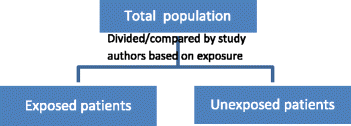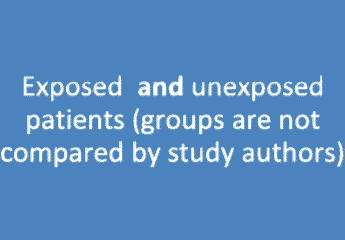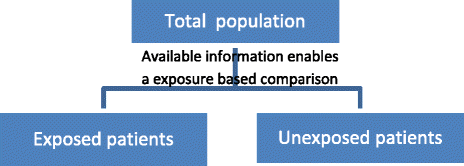I Am Doing a Review on a Cohort
- Debate
- Open Access
- Published:
Clarifying the distinction between case series and cohort studies in systematic reviews of comparative studies: potential impact on torso of evidence and workload
BMC Medical Enquiry Methodology volume 17, Article number:107 (2017) Cite this commodity
Abstruse
Distinguishing accomplice studies from case series is hard.
We suggest a conceptualization of cohort studies in systematic reviews of comparative studies. The primary aim of this conceptualization is to clarify the distinction between cohort studies and example series. Nosotros discuss the potential impact of the proposed conceptualization on the body of show and workload.
All studies with exposure-based sampling gather multiple exposures (with at least two different exposures or levels of exposure) and enable calculation of relative risks that should exist considered cohort studies in systematic reviews, including not-randomized studies. The term "enables/tin" means that a predefined analytic comparing is not a prerequisite (i.eastward., the accented risks per group and/or a take chances ratio are provided). Instead, all studies for which sufficient data are bachelor for reanalysis to compare dissimilar exposures (e.grand., sufficient data in the publication) are classified as accomplice studies.
There are possibly big numbers of studies without a comparing for the exposure of interest simply that exercise provide the necessary data to calculate issue measures for a comparison. Consequently, more studies could be included in a systematic review. Therefore, on the one hand, the outlined approach can increase the confidence in outcome estimates and the strengths of conclusions. On the other mitt, the workload would increment (e.g., additional data extraction and risk of bias cess, equally well every bit reanalyses).
Groundwork
Systematic reviews that include non-randomized studies oftentimes consider different observational written report designs [i]. All the same, the distinction betwixt dissimilar non-randomized report designs is difficult. One key pattern feature to allocate observational study designs is to distinguish comparative from non-comparative studies [2, 3]. The lack of a comparison group is of particular importance for distinguishing cohort studies from case serial because in many definitions, they share a primary design feature of having a follow-upward period examining the exposed individuals over time [2, 3]. The only departure betwixt cohort studies and example series in many definitions is that cohort studies compare different groups (i.e., examine the association betwixt exposure and effect), while case series are uncontrolled [3,iv,v]. Table 1 shows an case definition [iii]. The problem with this definition is that vague terms, such as comparison and exam of association, might exist interpreted as an analytic comparison of at least two exposures (i.e., interventions, risk factors or prognostic factors).
For example, imagine a study of 20 consecutive patients with a certain illness that can be treated in two different ways. A study that divides the 20 patients into ii groups according to the treatment received and compares the outcomes of these groups (e.g., provides aggregated absolute risks per group or a risk ratio) would be probably classified every bit a cohort study (the case used in the following sections is denoted "report 1"). A sample of this report blazon is illustrated in Fig. one and Tabular array 2.

Cohort study (vague definition)
In dissimilarity, a publication that describes the interventions received and outcomes for each patient/instance separately would probably be classified every bit a case series (the example in the following sections is denoted "study ii"). An example of this study type is illustrated in Fig. 2 and Table 3. In the medical literature, the data on exposure and outcomes are unremarkably provided in either running text or spreadsheet formats [6,7,8,9,10,xi,12,thirteen,xiv,xv,16,17,18,19,20,21]. A practiced example is the study by Wong et al. [10]. In this study, data on placental invasion (exposure) and claret loss (outcome) is separately provided for twoscore meaning women in a table. The study by Cheng et al. is an example of a report providing data in the running text (i.e., anticoagulation management [exposure] and recovery [outcome] for paediatric stroke) [vi].

Case series (vague definition)
These examples illustrate that distinguishing between cohort studies and instance series is hard. Vague definitions are probably the reason for the mutual confusion between report designs. A recent study institute that approximately 72% of cohort studies are mislabelled as case serial [22]. Many systematic reviews of not-randomized studies included accomplice studies but excluded case serial (run across examples in [23,24,25,26,27,28]). Therefore, the unclear distinction between case serial and cohort studies tin can upshot in inconsistent study selection and unjustified exclusions from a systematic review. The risk of misclassification is specially high because study authors also often mislabel their study or studies are not classified past their authors at all (see examples in [6,seven,8,9,10,11,12,xiii,14,15,xvi,17,18,nineteen,twenty,21]).
Objective
We propose a conceptualization of cohort studies in systematic reviews of comparative studies. The chief objective of this conceptualization is to analyze the distinction between cohort studies and case series in systematic reviews, including non-randomized comparative studies. We hash out the potential bear upon of the proposed conceptualization on the body of evidence and workload.
Clarifying the distinction betwixt case series and cohort studies (the solution)
In the following report, we propose a conceptualization for cohort studies and example serial (due east.g., sampling) for systematic reviews, including comparative non-randomized studies. Our proposal is based on a recent conceptualization of cohort studies and case series by Dekkers et al. [29]. The primary feature of this conceptualization is that it is exclusively based on inherent design features and is non affected by the analysis.
Cohort studies of one exposure/one grouping
Dekkers et al. [29] defined cohort studies with one exposure as studies with exposure-based sampling that enable calculating accented effects measures for a risk of outcome. This definition means that "the absenteeism of a control grouping in an exposure-based study does not ascertain a example series" [29]. The definition of cohort studies according to Dekkers et al. [29] is summarized in Table 4.
Cohort studies of multiple exposures/more than one group
This idea can exist hands extended to studies with more than than ane exposure. In this case, all studies with exposure-based sampling gathering multiple exposures (i.due east., at least ii unlike exposures, manifestations of exposures or levels of exposures) tin can be considered as (comparative) cohort studies (Fig. 3). The sampling is based on exposure, and there are dissimilar groups. Consequently, relative risks can be calculated [29]. The term "enables/can" implies that a predefined analytic comparison is not a prerequisite but that all studies with sufficient information to enable a reanalysis (e.one thousand., in the publication, study reports, and supplementary material) would be classified as cohort studies.

Cohort study (deduced from Dekkers et al. [28])
In short, all studies that enable adding of a relative risk to quantify a deviation in outcomes between different groups should be considered cohort studies.
Example series
According to Dekkers et al. [29], the sampling of a case series is either based on exposure and outcome (east.m., all patients are treated and accept an agin issue) or example series include patients with a certain consequence regardless of exposure (see Fig. iv). Consequently, no absolute gamble and also no relative consequence measures for an issue can exist calculated in a example series. Note that sampling in a case series does not need to exist consecutive. Consecutiveness would increment the quality of the example serial, only a not-consecutive series is besides a case series [29].

Case series (Deckers et al. [28])
In brusk, for a case serial, in that location are no accented risks, and also, no run a risk ratios can be calculated. Consequently, a instance series cannot be comparative. The definition of a case series by Dekkers et al. [29] is summarized in Table four.
It is noteworthy that the conceptualization also ensures a clear distinction of case series from other study designs that use outcome-based sampling. Case series, instance-command studies (including example-time-control), and self-controlled instance-command designs (e.m., case-crossover) all accept outcome-based sampling in common [29].
Example series take no control at all considering only patients with a certain manifestation of outcomes are sampled (e.g., individuals with a disease or deceased individuals). In contrast, all case-control designs as well as self-controlled example-control designs accept a control group. In case-control studies, the command group constitutes individuals with another manifestation of the outcome (e.1000., salubrious individuals or survivors). This outcome can be considered every bit two example series (i.e., case group and no case group).
Cocky-controlled case-control studies are characterized past an intra-individual comparison (each individual is their ain control) [thirty]. Information is also sampled when patients are not exposed. Therefore, case-control designs likewise every bit cocky-controlled case-control studies enable the calculation of gamble ratios. This arroyo is not possible for a case serial.
Illustrating example
Above, we illustrated that by using a vague definition, the classification of a report design might be influenced past the preparation and analysis of the report data. The proposed conceptualization is exclusively based on the inherent design features (e.g., sampling, exposure). After because the example studies again using the proposed conceptualization, all studies would be classified as cohort studies because the relative chance can be calculated. This upshot becomes clear looking at Table two and Table 3. If the patients in Table three are rearranged according the exposure and the data are reanalysed (i.e., calculation of absolute risk per group and relative risks to compare groups), Table 3 tin can be converted into Table 2 (and likewise, Fig. two can be converted to Fig. three). In the study by Wong et al. [10], the hateful claret loss in the grouping with placental invasion and in the group without placental invasion can be calculated and compared (e.g., relative risk with 95% conviction limits). In this written report, the data on gestational historic period are likewise provided in the tabular array. Therefore, it is fifty-fifty possible to adjust the results for gestational age (e.m., using a logistic regression).
Discussion (the affect)
Influence on the torso of testify
The proposed conceptualization is exclusively based on inherent study design features; therefore, there is less room for misinterpretation compared to existing conceptualizations because analysis features, presentation of data and labelling of the study are not adamant. Thus, the conceptualization ensures consistent study selection for systematic reviews.
The prerequisite of an analytical comparison in the publication can lead to the unjustified exclusion of relevant studies from a systematic review. Report one would likely exist included, and Study ii would exist excluded from the systematic review. The just differences between Study i and Study 2 are the analysis and preparation of data. If the data source (e.yard., chart review) and the reanalysis (adding of effect measures and statistical tests) to compare the intervention and control group in Study ii are performed exactly with the same approach every bit the existing assay in Study one, there tin exist no difference in the effect estimates between studies, and the studies are at the aforementioned chance of bias. Thus, the inclusion of Study one and the exclusion of Study ii are contradictory to the requirement that systematic reviews identify all available evidence [31].
Considering that more studies would exist eligible for inclusion and that the hierarchical paradigm of the levels of evidence is not valid per se, the proposed conceptualization can potentially enrich bodies of evidence and increase confidence in upshot estimates.
Influence on workload
The additional inclusion of all studies that enable calculating relative risk for the comparing of interest might impact the workload of systematic reviews. In that location might exist a considerable number of studies not performing a comparing already but that provide sufficient data for reanalysis. Usually the electronic search strategy for systematic reviews of non-randomized studies is non limited to certain study types considering there are no sensitive search filters available yet [32]. Therefore, the search results do non normally include cohort studies every bit discussed above. However, in many abstracts it would exist not directly clear if sufficient data for re-calculations are reported in the total text article (e.1000., a table similar Table three). Consequently, many additional potentially relevant full-text studies take to be screened. Additionally, studies ofttimes assess various exposures (e.k., different baseline characteristics), and it might thus exist difficult to identify relevant exposures. Considering the large amount of wrongly labelled studies, this approach can lead to additional screening endeavor [22].
As a result, more studies would be included in systematic reviews. All articles that provide potentially relevant data would accept to be assessed in detail to decide whether reanalysis is feasible. For these information extractions, a risk of bias cess would have to be performed. Challenges in the run a risk of bias assessment would arise because most cess tools are synthetic to assess a predefined control group [33]. For example, items regarding the adequacy of analysis (e.g., adjustment for confounders) cannot exist assessed anymore. Effect measures must be calculated (e.g., risks by group and relative risk with a 95% confidence limit), and eventually further analyses (e.g., adjustments for confounders) might be necessary for studies that provide sufficient information. Moreover, avant-garde biometrical expertise would be necessary to guess the feasibility (i.e., determining the possibility to calculate relative risks and whether at that place are sufficient data to adjust for confounders) of a re-analysis and to conduct the reanalysis.
Promising areas of application
In the medical literature, it is likely that more retrospective mislabelled cohort studies (comparison planned after data collection) based on routinely nerveless data (e.g., chart review, review of radiology databases) than prospectively planned (i.e., comparisons planned before information collection) and wrongly labelled cohort studies tin be establish. Thus, information technology tin exist assumed that the wrongly labelled studies tend to take lower methodological quality than studies that already include a comparison. This aspect should be considered in decisions about including studies that must be reanalysed. In research areas in which randomized controlled trials or large planned prospective and well-conducted accomplice studies can exist expected (east.one thousand., risk factors for widespread diseases), the approach is less promising for enriching the trunk of evidence. Consequently, in these areas, the additional try might not be worthwhile.
Over again, the conceptualization is particularly promising in research areas in which evidence is sparse because studies are difficult to conduct or populations are small or the event rates are low. These areas include rare diseases, adverse events/complications, sensitive groups (e.g., children or individuals with cognitive deficiencies) or rarely used interventions (due east.g., costly innovations). In these areas, there might be no well-conducted studies at all [34, 35]. Therefore, the proposed conceptualization in this report has great potential to increase confidence in upshot estimates.
Determination
We proposed a conceptualization for cohort studies with multiple exposures that ensures a clear stardom from case serial. In this conceptualization, all studies that contain sufficient information to conduct a reanalysis and non but studies with a pre-existing analytic comparison are classified as cohort studies and are considered appropriate for inclusion in systematic reviews. To the all-time of our cognition, no systematic reviews exist that reanalyse (mislabelled) case serial to create cohort studies. The outlined approach is a method that can potentially enrich the torso of evidence and subsequently heighten confidence in effect estimates and the strengths of conclusions. However, the enrichment of the body of evidence should exist balanced confronting the additional workload.
References
-
Ijaz S, Verbeek JH, Mischke C, Ruotsalainen J. Inclusion of nonrandomized studies in Cochrane systematic reviews was establish to exist in need of improvement. J Clin Epidemiol. 2014;67(half dozen):645–53.
-
Ev E, Altman DG, Egger M, Pocock SJ, Gøtzsche PC, Vandenbroucke JP. Strengthening the reporting of observational studies in epidemiology (STROBE) argument: guidelines for reporting observational studies. BMJ. 2007;335(7624):806–8.
-
Reeves BC, Deeks JJ, Higgins JP. xiii including non-randomized studies. Cochrane Handbook Syst Rev Interventions. 2008;one:391.
-
Hartling L, Bond K, Santaguida PL, Viswanathan 1000, Dryden DM. Testing a tool for the classification of study designs in systematic reviews of interventions and exposures showed moderate reliability and low accurateness. J Clin Epidemiol. 2011;64(viii):861–71.
-
EPOC-specific resource for review authors: What report designs should exist included in an EPOC review and what should they be chosen? [http://epoc.cochrane.org/resources/epoc-resources-review-authors]. Accessed 12 July 2017.
-
Cheng WW, Ko CH, Chan AK. Paediatric stroke: case series. Hong Kong Med J. 2002;8(3):216–xx.
-
Hernot S, Wadhera R, Kaintura M, Bhukar Due south, Pillai DS, Sehrawat U, George JS. Tracheocutaneous fistula closure: comparing of rhomboid flap repair with Z Plasty repair in a case series of forty patients. Aesthet Plast Surg. 2016.
-
Stacchiotti South, Provenzano S, Dagrada Grand, Negri T, Brich South, Basso U, Brunello A, Grosso F, Galli 50, Palassini E, et al. Sirolimus in avant-garde Epithelioid Hemangioendothelioma: a retrospective case-series analysis from the Italian rare cancer network database. Ann Surg Oncol. 2016;23(9):2735–44.
-
Sofiah Due south, Fung LYC. Placenta accreta: clinical adventure factors, accuracy of antenatal diagnosis and effect on pregnancy result. Med J Malays. 2009;64(4):298–302.
-
Wong HS, Hutton J, Zuccollo J, Tait J, Pringle KC. The maternal issue in placenta accreta: the significance of antenatal diagnosis and non-separation of placenta at delivery. N Z Med J. 2008;121(1277):thirty–8.
-
Mayorandan S, Meyer U, Gokcay K, Segarra NG, de Baulny HO, van Spronsen F, Zeman J, de Laet C, Spiekerkoetter U, Thimm E, et al. Cantankerous-sectional written report of 168 patients with hepatorenal tyrosinaemia and implications for clinical do. Orphanet J Rare Dis. 2014;nine(1):107.
-
Bartlett DC, Lloyd C, McKiernan PJ, Newsome PN. Early nitisinone treatment reduces the need for liver transplantation in children with tyrosinaemia type 1 and improves post-transplant renal function. J Inherit Metab Dis. 2014;37(5):745–52.
-
El-Karaksy H, Fahmy 1000, El-Raziky K, El-Koofy North, El-Sayed R, Rashed MS, El-Kiki H, El-Hennawy A, Mohsen N. Hereditary tyrosinemia type one from a single heart in Egypt: clinical study of 22 cases. World J Pediatr. 2011;7(three):224–31.
-
Zeybek Air-conditioning, Kiykim E, Soyucen E, Cansever South, Altay S, Zubarioglu T, Erkan T, Aydin A. Hereditary tyrosinemia blazon ane in Turkey: twenty yr unmarried-centre experience. Pediatr Int. 2015;57(2):281–9.
-
Helmy Northward, Akl Y, Kaddah Southward, El Hafiz HA, El Makhzangy H. A instance series: Egyptian experience in using chemic pleurodesis as an alternative management in refractory hepatic hydrothorax. Arch Med Sci. 2010;6(3):336–42.
-
Niesen Advertisement, Sprung J, Prakash YS, Watson JC, Weingarten TN. Case series: coldhearted management of patients with spinal and bulbar muscular atrophy (Kennedy's disease). Can J Anaesth. 2009;56(2):136–41.
-
de Mauroy JC, Journe A, Gagaliano F, Lecante C, Barral F, Pourret S. The new Lyon ARTbrace versus the historical Lyon brace: a prospective case series of 148 sequent scoliosis with brusque fourth dimension results after 1 twelvemonth compared with a historical retrospective case series of 100 consecutive scoliosis; SOSORT honour 2015 winner. Scoliosis. 2015;x:26.
-
Forner D, Phillips T, Rigby M, Hart R, Taylor M, Trites J. Submental isle flap reconstruction reduces cost in oral cancer reconstruction compared to radial forearm complimentary flap reconstruction: a case serial and toll assay. J Otolaryngol Caput Cervix Surg. 2016;45:eleven.
-
Kuhnt D, Bauer MHA, Sommer J, Merhof D, Nimsky C. Optic radiation fiber Tractography in Glioma patients based on high angular resolution diffusion imaging with compressed sensing compared with diffusion tensor imaging - initial experience. PLoS One. 2013;eight(7):e70973.
-
Naesens R, Vlieghe E, Verbrugghe W, Jorens P, Ieven Yard. A retrospective observational report on the efficacy of colistin by inhalation as compared to parenteral administration for the treatment of nosocomial pneumonia associated with multidrug-resistant Pseudomonas Aeruginosa. BMC Infect Dis. 2011;eleven:317.
-
Toktas ZO, Konakci Thousand, Yilmaz B, Eksi MS, Aksoy T, Yener Y, Koban O, Kilic T, Konya D. Hurting control following posterior spine fusion: patient-controlled continuous epidural catheter infusion method yields better mail-operative analgesia control compared to intravenous patient controlled analgesia method. A retrospective example series. Eur Spine J. 2016;25(5):1608–13.
-
Esene IN, Ngu J, Zoghby Thou, Solaroglu I, Sikod AM, Kotb A, Dechambenoit G, Husseiny H. Case series and descriptive cohort studies in neurosurgery: the confusion and solution. Childs Nerv Syst. 2014;xxx(8):1321–32.
-
Kellesarian SV, Yunker Thousand, Ramakrishnaiah R, Malmstrom H, Kellesarian TV, Ros Malignaggi 5, Javed F. Does incorporating zinc in titanium implant surfaces influence osseointegration? A systematic review. J Prosthet Paring. 2017;117(i):41–7.
-
Wijnands TF, Gortjes AP, Gevers TJ, Jenniskens SF, Kool LJ, Potthoff A, Ronot Grand, Drenth JP. Efficacy and safety of aspiration Sclerotherapy of uncomplicated hepatic cysts: a systematic review. AJR Am J Roentgenol. 2017;208(1):201–vii.
-
Zapata LB, Oduyebo T, Whiteman MK, Houtchens MK, Marchbanks PA, Curtis KM. Contraceptive use among women with multiple sclerosis: a systematic review. Contraception. 2016;94(6):612–20.
-
Dogramaci EJ, Rossi-Fedele G. Establishing the association between nonnutritive sucking behavior and malocclusions: a systematic review and meta-analysis. J Am Dent Assoc. 2016;147(12):926–34. e926.
-
Kellesarian SV, Abduljabbar T, Vohra F, Gholamiazizi E, Malmstrom H, Romanos GE, Javed F. Does local Ibandronate and/or Pamidronate delivery enhance Osseointegration? A systematic review. J Prosthodont. 2016.
-
Crandall Thou, Eastman A, Violano P, Greene Due west, Allen S, Block E, Christmas AB, Dennis A, Duncan T, Foster Due south, et al. Prevention of firearm-related injuries with restrictive licensing and concealed behave laws: an eastern Association for the Surgery of trauma systematic review. J Trauma Astute Intendance Surg. 2016;81(5):952–60.
-
Dekkers OM, Egger M, Altman DG, Vandenbroucke JP. Distinguishing case serial from accomplice studies. Ann Intern Med. 2012;156(1_Part_1):37–40.
-
Petersen I, Douglas I, Whitaker H. Self controlled example series methods: an alternative to standard epidemiological report designs. BMJ. 2016;354.
-
Higgins JP, Green Due south. Cochrane handbook for systematic reviews of interventions, vol. five: Wiley Online Library; 2008.
-
Marcano Belisario JS, Tudor Car L, Reeves TJA, Gunn LH, Car J. Search strategies to identify observational studies in MEDLINE and EMBASE. Cochrane Database Syst Rev. 2013;12.
-
Hayden JA, van der Windt DA, Cartwright JL, Cote P, Bombardier C. Assessing bias in studies of prognostic factors. Ann Intern Med. 2013;158(iv):280–six.
-
Plant for Quality and Efficiency in Health Care (IQWIG): Newborn screening for astringent combined immunodeficiency (S15–02). In.; 2017.
-
Found for Quality and Efficiency in Health Care (IQWIG): Newborn screening for tyrosinaemia type ane (S15–01). In.; 2017.
Acknowledgements
None.
Funding
In that location was no external funding for the research or publication of this article.
Availability of information and materials
Not applicable.
Author information
Affiliations
Contributions
All authors have made substantial contributions to the piece of work. Both authors read and approved the concluding manuscript.
Corresponding writer
Ethics declarations
Ideals approving and consent to participate
Not applicable. No human being information involved.
Consent for publication
Not applicable. The manuscript contains no individual person's data.
Competing interests
The authors declare that they have no competing interests.
Publisher'due south Note
Springer Nature remains neutral with regard to jurisdictional claims in published maps and institutional affiliations.
Rights and permissions
Open Access This commodity is distributed under the terms of the Creative Commons Attribution 4.0 International License (http://creativecommons.org/licenses/past/4.0/), which permits unrestricted use, distribution, and reproduction in whatever medium, provided you requite advisable credit to the original author(s) and the source, provide a link to the Creative Eatables license, and indicate if changes were made. The Creative Commons Public Domain Dedication waiver (http://creativecommons.org/publicdomain/zero/1.0/) applies to the information made available in this article, unless otherwise stated.
Reprints and Permissions
Nearly this article
Cite this commodity
Mathes, T., Pieper, D. Clarifying the stardom between instance series and cohort studies in systematic reviews of comparative studies: potential impact on body of evidence and workload. BMC Med Res Methodol 17, 107 (2017). https://doi.org/ten.1186/s12874-017-0391-8
-
Received:
-
Accustomed:
-
Published:
-
DOI : https://doi.org/ten.1186/s12874-017-0391-eight
Keywords
- Defined Report Cohort
- Systematic Review
- Extract Additional Information
- Bias Assessment
- Placental Invasion
Source: https://bmcmedresmethodol.biomedcentral.com/articles/10.1186/s12874-017-0391-8
0 Response to "I Am Doing a Review on a Cohort"
ارسال یک نظر